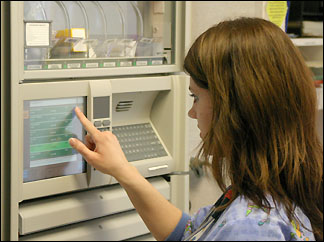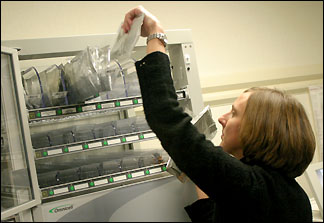New pharmacy machine in operation at hospital
The Omnicell machine arrived at the Paynesville Area Health Care System in January and started operation on Monday, Feb. 7. It manages the medication supply, with a central server, or "brains," in the pharmacy department and two Omni-dispensers in the hospital: one located on the general ward and the other in the emergency wing.
The Omni center, as the central server is called, keeps an instantaneous record of the medication supply in the dispensers and real-time feedback. It should help the staff "make sure patients get the right med at the right time by the right person," said Pharm.D. Todd Lemke.
 The Omnicell system dispenses common medicines, prescription drugs (even ones that need to be refrigerated), and certain supplies (like needles and syringes that need to be kept secure) while keeping a running record of the stock.
The Omnicell system dispenses common medicines, prescription drugs (even ones that need to be refrigerated), and certain supplies (like needles and syringes that need to be kept secure) while keeping a running record of the stock.
Elizabeth Johnson, a registered nurse at PAHCS, accesses medications in the new Omni dispenser in the emergency wing at the hospital.
Previously, drugs in the hospital were stored in carts, covering 24-hours of medication for patients, with additional, more common medicines (like aspirin) stocked for the nursing staff. Records were done by paper, and thus were subject to human error and faced a delay for processing time. To track medicine and keep inventory by paper trail involved many accurate steps, subject to human error, and the paper trail was not complete for days, whereas Omnicell can give immediate response.
By having better records, the Omnicell machine should also generate better charges for PAHCS. PAHCS misses an estimated $6,000 in pharmacy charges per year right now, said Lemke. Omnicell interfaces with the health information network at PAHCS, including billing. With Omnicell, any mistakes in medication can be tracked because it provides a trail of who gave the medicine, when, and how much, etc., said Lemke and Kris Cervin, another Pharm.D. at PAHCS.
The Omnicell also allows nurses more rapid access to medication, they added.
The automated system also immediately checks all expiration dates. The bar codes for medications are scanned when stocked, entering the expiration date automatically in the Omni center. Eventually nurses could use a bar code when withdraw ing medications, and each patient, could have a bar code, too, which would be another safety precaution before the administering a drug.
 This running count proves especially convenient in checking narcotics, which must be totaled during every nursing shift. Previously, it took two nurses 20 minutes every shift to check the narcotics stock by hand, totalling two hours of nursing time per day.
This running count proves especially convenient in checking narcotics, which must be totaled during every nursing shift. Previously, it took two nurses 20 minutes every shift to check the narcotics stock by hand, totalling two hours of nursing time per day.
Pharm.D. Kris Cervin restocks the Omni dispenser at the Paynesville Area Hospital. The new machine should increase safety for patients while saving time for nurses and pharmacy.
The Omnicell machine should also help the pharmacy department, which consists of two Pharm.D.s, a Pharm.D. resident, two full-time technicians, and a part-time tech. Instead of having to fill carts for the hospital every 24 hours, Omnicell should allow the pharmacy to manage hospital medications more easily. Right now, the Pharm.D.s and the Pharm.D. resident rotate call: 24-hours-per-day, seven-days-per-week, with each getting call duty every third week. On weekends, this means spending three hours per day filling the cart and checking on medications for new patients.
The Omnicell system should eliminate the need to restock on weekends and could eventually allow Pharm.D.s to do the review of drugs for new hospital patients on weekends from home via the Internet.
Time savings for nursing and pharmacy are important with a tight labor market for both in outstate Minnesota, said Lemke. "We've wanted this (machine) for quite a few years," he added.
Over $1 million in medication is used in the hospital per year, with an average of 3,000 to 3,800 doses per month. The Omnicell system should mean less dispensing for the Pharm.D.s and more time reviewing patients' medications. (Pharm.D.s review patient charts to insure that the right medications are given, in the desired doses, and yield the desired effects. It's their job, said Lemke, to make sure that medications are indicated by a doctor, safe, and effective.)
PAHCS received a Rural Hospital Capital Improvement Grant for $100,000 to purchase the Omnicell system, which cost approximately $200,000 for PAHCS. A committee - consisting of pharmacy, nurses, administration, IT, and facilities management - researched the machine before the purchase.
Since November, Cervin has suspended her clinic hours in order to set up the new machine. She attended training in California in January and conducted staff training after the machine arrived and was set up. For a week, they stocked the dispensers with candy to let staff get used to using it. It went live on Monday, Feb. 7.
About 80 percent of the medicines used at the hospital are currently stocked in the Omnicell machine. Their goal is to dispense 90 or 95 percent of the drugs in the hospital automatically with the machine.
PAHCS eventually could add more dispensers to its Omnicell system, said Cervin and Lemke, in critical care, in the birthing suites, in its operating rooms, and in the specialty (outreach) clinic.
Contact the author at editor@paynesvillepress.com • Return to News Menu
Home | Marketplace | Community